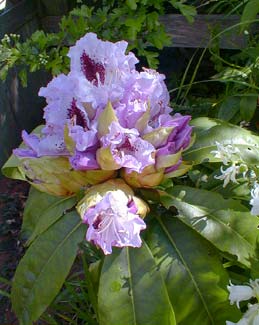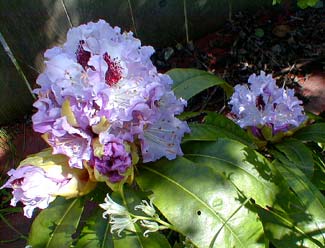 Rhododendron 'Blue Peter'
Rhododendron 'Blue Peter'
"At my age flowers scare me."
-George Burns
(1896-1996)
(1896-1996)
'Blue Peter' has been gardened since 1933. Its immediate heritage is not really known, but it's one of the classic American "Iron Clads," such as are cold-hardy (to minus ten for Blue Peter), & tolerates considerable sunlight or heat.
It has R. cawtawbiense prominantly in its family tree, with most likely some R. ponticum tossed in. But the specific Catawba & Ponticum cultivars that produced it went unrecorded.
It is one of the most gorgeous of the old classics & not likely ever to be displaced in gardeners' affections.
Blue Peter has been used in further hybridizations in the endless attempt to achieve a true blue large evergreen rhododendron. It is, however, like most so-called blues, not quite blue, but rather the palest violet-lavender with dark maroon speckled blotches in the throat, having frilled edges to the individual trumpets.
The frills & dark throat give it almost the look of an orchid's bloom, & in just the right light you really can fool yourself that it is pale blue.
 The blooms are quite large, which can look unproportional on an infant shrub such as we obtained. So my trick was to provide it with a space where it had room to grow but where it seemed an extension of something already large, so that Blue Peter isn't required to immediately stand on its own as a specimen.
The blooms are quite large, which can look unproportional on an infant shrub such as we obtained. So my trick was to provide it with a space where it had room to grow but where it seemed an extension of something already large, so that Blue Peter isn't required to immediately stand on its own as a specimen.The specific location is on the back edge of the property near a hawthorn tree, in an area that is virtually never watered & only the compost heap is ever tended. It's on a sudden drop-off with rather too good a drainage, so that Blue Peter often experiences droughty conditions, reliant on natural rainfall. But for an iron-clad rhody, neglect cannot harm it.
How long before a tiny shrub can be proud as the center of attention? Well, optimistic growers consider it to be fast-growing, but that is on the rhody scale of slow, awfully slow, & where is that damned bus anyway. If you're used to the speed of spiraeas then Blue Peter will appear motionless, but compared to other rhodies he'll seem to be sprawling & upreaching in no time.
Ours was obtained as a small, forked limb that had been pruned & rooted in a mere gallon pot. Though it did not bloom the first year it was situated to look like it was reaching out from under a hawthorne, the May photos on this page are from its second year.